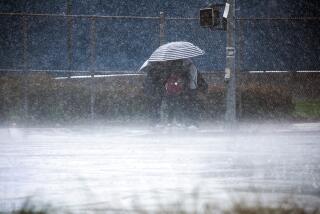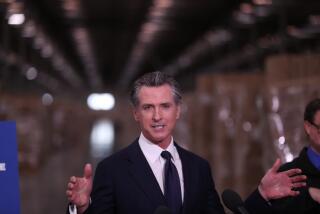Newsom orders more aid to California campuses shuttered by coronavirus, opting not to close schools statewide
SACRAMENTO â California schools that close their doors due to the novel coronavirus outbreak will continue to receive funding under an executive order issued on Friday by Gov. Gavin Newsom, with a directive to direct more dollars toward remote learning opportunities and child care options during workday hours.
The executive order did not, however, go as far as some educators had wanted.
There had been expectations that Newsom would instead require all California schools â not just public but even private schools â to temporarily cease operations in response to the global pandemic. Hours before he acted, trustees of the Los Angeles Unified School District and other schools in the stateâs largest cities made the difficult decision to close their doors. Some two-thirds of the stateâs students now face days or weeks away from the classroom. But some 2 million more will be expected to be back in class on Monday.
In the end, Newsom chose instead to focus the stateâs response on easing the financial blow felt by the suspension of classes in dozens of communities.
âClosing schools has a massive, cascading effect for our kids and their families â especially those least equipped financially to deal with them,â Newsom said in an emailed statement. âThe needs of California kids must be met regardless of whether their school is open or closed. School districts that choose to close must use state educational dollars to quickly meet the needs of children and families. The State of California is working around the clock to help those districts and provide best practices to ensure no kid is left behind.â
The executive order calls on schools to use the guarantee of continued funding to look for ways to continue educational coursework at a distance and to provide ways to keep school meals and for âsupervision for students during ordinary school hours.â
About 90 minutes before Newsom issued his directive, the California Teachers Assn. urged him to go further.
âTo protect students and educators, we believe closing all public schools and community colleges would be one of the safest measures to help mitigate further spreading of the virus right now,â said E. Toby Boyd, the president of the teachersâ union.
When asked by The Times why Newsom chose not to order a statewide school closure, the governorâs office said he was directing his attention to the necessities of students.
âA week ago, state public health officials made detailed recommendations on when local school districts should close schools based on community conditions and the spread of COVID-19,â the governorâs spokesman, Jesse Melgar, said in a statement. âNow that school districts are closing, the Governorâs focus is on ensuring studentsâ needs are met â whether or not their school is physically open.â
The decision came after a day full of far-reaching actions in response to the coronavirus crisis. President Trump declared a national emergency to expedite the flow of federal dollars to local communities, and state officials extended until June 15 the deadline for those affected by the virus to file their California income tax returns.
But by dayâs end, at least 16 states and the District of Columbia had fully shuttered their schools, including neighboring states Oregon and Washington and high-population states such as Florida.
In California, the decisions were piecemeal. All but one of the stateâs 10 largest school districts ordered temporary school closures by Friday afternoon and the one outlier, the Capistrano Unified School District in Orange County, scheduled a vote on school closures for Friday evening.
Newsom may have stopped short of closing all schools due to concerns over the widespread financial, workforce and household disruptions such a decision could cause. Among the parents forced to miss work to care for their children at home will be healthcare providers who are desperately needed at hospitals and other medical facilities, places that could be overwhelmed by coronavirus patients.
Roughly 80% of students at Californiaâs public schools receive free or reduced-price meals. Last week the U.S. Department of Agriculture approved a request by the Newsom administration to allow meal service during school closures, permitting families to pick up those meals at libraries, parks or other off-site locations.
âThatâs why, again, we have to be very thoughtful and consider it as it relates to our education system and the broader impacts,â the governor said Thursday.
The guarantees announced on Friday are key for local education leaders. Unlike other states, California primarily pays for K-12 education based on the number of children who actually show up, not the overall student enrollment. The âaverage daily attendanceâ formula means less funding when students are absent â a policy that often has a disproportionate effect on schools in low-income communities where attendance can be more inconsistent.
California taxpayers are expected to spend more than $85 billion on K-12 schools in the state fiscal year that ends in June and more than $87 billion in the year after that under budget plans offered by Newsom. While some of that money comes from local property taxes, the vast majority of it is allocated by the state. The action by the governor ensures those dollars continue to flow even if schools remain closed.
Even so, the funding impact of closing schools could require expedited action by the Legislature. On Thursday, as individual schools and districts around the state were closing their doors, Senate President Pro Tem Toni Atkins (D-San Diego) said lawmakers would consider all options as soon as possible.
âFiscally, it is critically important for the school districts,â she said.
Less clear on the long-term impact on students is whether lawmakers will revisit the length of the school year, which is set in current law as at least 175 days. Lawmakers first allowed schools to reduce the number of days of instruction down from 180 days back in 2008, driven then by steep budget cuts in response to the global recession.
Education advocates said itâs still too early to determine whether the school year would need to be extended into the summer months and, along with that, whether upcoming state-mandated standardized tests will be postponed or canceled altogether.
Elk Grove Unified School District, south of Sacramento and the largest district in Northern California, was the first in the state to shut down. Since then, schools have been temporarily closed by Los Angeles Unified School District, San Francisco Unified School District and several districts in Ventura County including Simi Valley, Moorpark and Oak Park.
Universities nationwide â including California schools such as UCLA, USC, UC San Diego and Stanford â have transitioned to providing online learning options, electing to shut down classroom instruction.
Earlier this week Newsom called for the cancellation of all gatherings of over 250 people and on Thursday he announced that the state, if needed, will commandeer hotels and medical facilities to help care of coronavirus patients.
California health officials reported five coronavirus related deaths and 247 confirmed cases in the state as of Friday morning. That does not count passengers from the Grand Princess cruise ship currently docked in Oakland.
More to Read
Sign up for Essential California
The most important California stories and recommendations in your inbox every morning.
You may occasionally receive promotional content from the Los Angeles Times.





![[20060326 (LA/A20) -- STATING THE CASE: Marchers organized by unions, religious organizations and immigrants rights groups carry signs and chant in downtown L.A. "People are really upset that all the work they do, everything that they give to this nation, is ignored," said Angelica Salas of the Coalition of Humane Immigrant Rights. -- PHOTOGRAPHER: Photographs by Gina Ferazzi The Los Angeles Times] *** [Ferazzi, Gina -- - 109170.ME.0325.rights.12.GMF- Gina Ferazzi/Los Angeles Times - Thousands of protesters march to city hall in downtown Los Angeles Saturday, March 25, 2006. They are protesting against House-passed HR 4437, an anti-immigration bill that opponents say will criminalize millions of immigrant families and anyone who comes into contact with them.]](https://ca-times.brightspotcdn.com/dims4/default/34f403d/2147483647/strip/true/crop/1983x1322+109+0/resize/840x560!/quality/75/?url=https%3A%2F%2Fcalifornia-times-brightspot.s3.amazonaws.com%2Fzbk%2Fdamlat_images%2FLA%2FLA_PHOTO_ARCHIVE%2FSDOCS%2854%29%2Fkx3lslnc.JPG)






